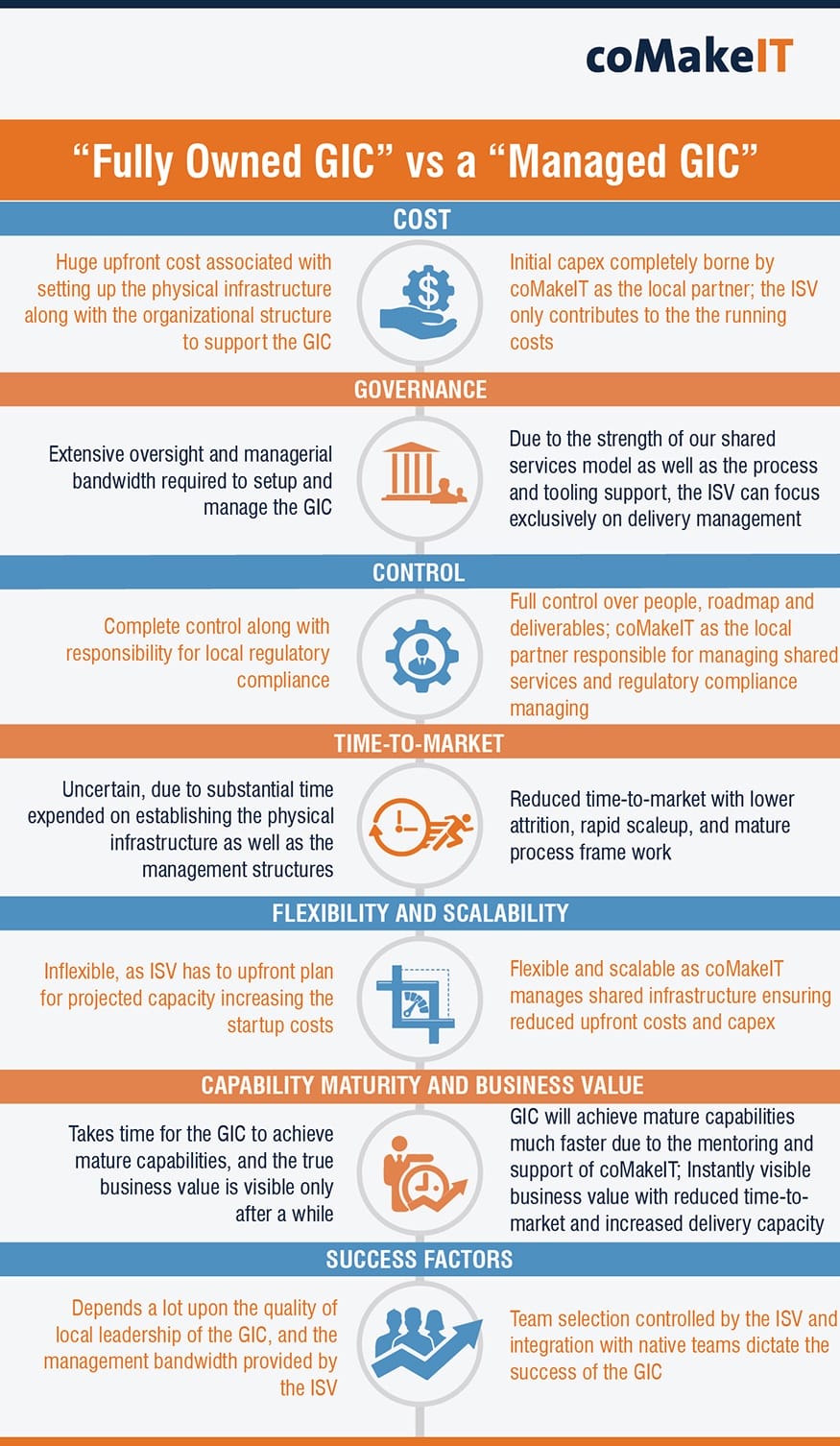The past few decades witnessed an explosive growth in IT outsourcing and emergence of India as a major offshoring destination with access to a vast, low-cost talent pool. During this period, the nature of services provided through outsourcing has also transformed from mere cost arbitrage to high quality, innovative services with strategic value.
In the early days of outsourcing, ISVs were reluctant to embrace offshoring due to concerns on capability, and maturity of the service providers, as well as a desire to stay in control of their product road maps. The emergence of captive development centers (catering exclusively to the parent company), also termed as Global In-house Centers (GIC) opened the door for many ISVs to reap the advantages of offshoring (without sacrificing control over their technology roadmap), and overcome the crippling shortage of talent in their native markets.
Over the years, many well-established ISVs have setup fully owned captive GICs in India, and took advantage of its eco system of well-trained technology talent, coupled with a relatively low cost structure and world class infrastructure. In addition to investing substantial resources to meet the startup costs associated with establishing a fully owned GIC, the parent companies supported them through dedicated management bandwidth, to ensure that over a period of time, these GICs achieve mature capabilities. In recent years, to deal with the rapid pace of technology and business change, parent companies are challenging these GICs to transition from pure play cost centers to centers capable of delivering quality, innovation, and strategic value, all in a condensed time scale. As a recent report from Deloitte pointed out, the evolution from a pure-play cost center to that of a GIC capable of innovation takes time, as well as organizational and process maturity.
However, the high initial capex barrier, coupled with an uncertain payoff sometime in the future, has restricted offshoring as an option to most mid to large ISVs, which lacked the financial and organizational strength of their well-established peers. Even when confronted with crippling talent shortages and capacity constraints, and in spite of the obvious access to a vast low-cost talent pool, many ISVs hesitated to take the offshoring plunge:
- as they either lacked the financial resources to meet the upfront startup costs for setting up a fully owned GIC
- lack of risk appetite to invest in a GIC that will take time to mature
- absence of governance framework or leadership bandwidth to manage a fully owned GIC
We, at coMakeIT have come up with an innovative service delivery model to address the primary concerns of mid to large ISVs which seek to explore offshoring, namely: high startup costs, risk mitigation, governance, and ability to rapidly scale in maturity as well as capability. Over the past decade coMakeIT, a mature service provider with a software product development DNA, has evolved and perfected ‘Managed Global In-house Centers (GICs)”, a strategic engagement framework that enabled mid to large ISVs benefit from the proven advantages of offshoring in India.
Key features of “Managed GIC”
Through its unique bouquet of shared services coMakeIT enables ISVs to focus solely on their product roadmap and innovation needs, without having to deal with the nitty-gritty of managing the offshore center. The Managed GIC framework of coMakeIT is characterized by the following key differentiating features:
- No need for the ISV to make any upfront investment in capex, which is done by coMakeIT
- ISV can focus solely on delivery management (as opposed to site/center management)
- coMakeIT supports the ISV through shared services in the form of infrastructure, ICT, HR, and payroll
- Benefit from the product development DNA of coMakeIT to ensure rapid process maturity, leading to higher quality, productivity, and reduced time-to-market
- Proven ability to put together a dedicated team with low attrition
This unique model of coMakeIT enables ISVs to lower their initial investment, mitigate risks, and ensure that their GICs scale up, and achieve the process maturity and capability to meet the innovation needs of the parent company in a much shorter time frame.The following infographic captures the relative advantages of a “Managed GIC” vs a “Fully Owned GIC”:

Our experience over the past decade, and the successful engagement with numerous ISVs of varying sizes from across Europe, UK, and Australia have validated the strength of our model, and reinforced the relative advantages of a “Managed GIC” vs a “fully owned GIC”.
Planon, a leading European ISV (recognized by Gartner as a leader of the IWMS magic quadrant) is one of the earliest adapter of our model, and has reaped substantial benefits from our strategic engagement. Our successful partnership dates back to early 2008, when coMakeIT has set up a dedicated scrum team of 8 people, which quickly grew up to 24 people in a years’ time. Currently Planon India GIC has a strength of 100+, and is growing at a clip of 20% annually. The GIC managed by coMakeIT started with product development R&D, and expanded in scope to handle services, and support for Planon’s entire product suite encompassing all of its service jurisdictions.
We currently have successful partnerships with more than 20 ISVs from across the world, managing GICs ranging in size from a scum team of 8 to a full-fledged GIC with 100+ strength.




